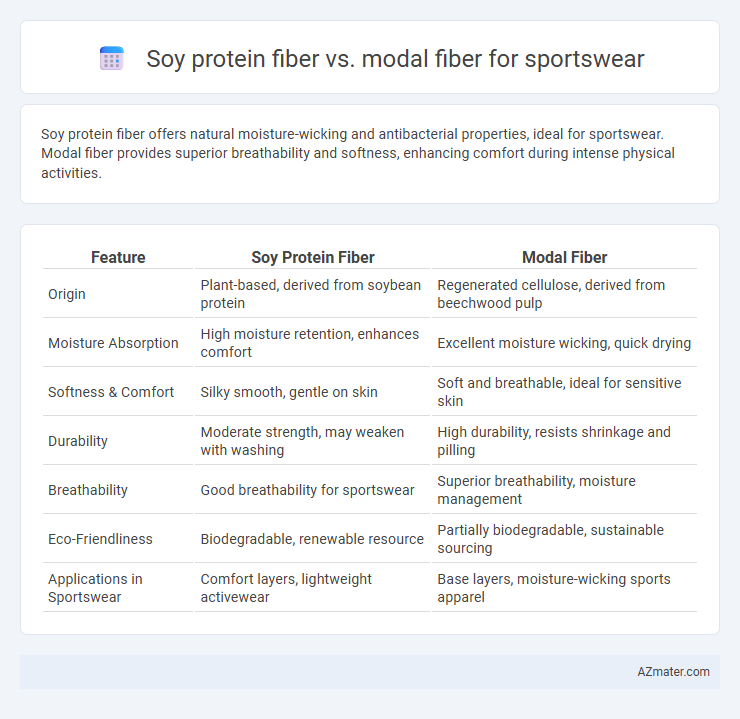Soy protein fiber offers natural moisture-wicking and antibacterial properties, ideal for sportswear. Modal fiber provides superior breathability and softness, enhancing comfort during intense physical activities.
Table of Comparison
| Feature | Soy Protein Fiber | Modal Fiber |
|---|---|---|
| Origin | Plant-based, derived from soybean protein | Regenerated cellulose, derived from beechwood pulp |
| Moisture Absorption | High moisture retention, enhances comfort | Excellent moisture wicking, quick drying |
| Softness & Comfort | Silky smooth, gentle on skin | Soft and breathable, ideal for sensitive skin |
| Durability | Moderate strength, may weaken with washing | High durability, resists shrinkage and pilling |
| Breathability | Good breathability for sportswear | Superior breathability, moisture management |
| Eco-Friendliness | Biodegradable, renewable resource | Partially biodegradable, sustainable sourcing |
| Applications in Sportswear | Comfort layers, lightweight activewear | Base layers, moisture-wicking sports apparel |
Introduction to Soy Protein Fiber and Modal Fiber
Soy protein fiber, derived from soybean protein, offers exceptional moisture-wicking and breathability, making it ideal for sportswear that requires comfort and odor resistance. Modal fiber, made from beech tree cellulose, boasts superior softness, durability, and excellent moisture absorption, enhancing athletic apparel's performance and comfort. Both fibers provide eco-friendly alternatives with unique properties suited for activewear, yet soy protein fiber emphasizes biodegradability and anti-bacterial features, while modal excels in smooth texture and color retention.
Fiber Origins and Production Processes
Soy protein fiber is derived from soybeans through a process that extracts soy protein isolate and spins it into fiber, offering a renewable, plant-based alternative with natural moisture-wicking properties. Modal fiber, produced from beech tree pulp using a chemical process involving spinning cellulose into smooth, durable fibers, provides excellent breathability and softness suited for activewear. Both fibers are sustainable choices, with soy protein fiber favoring agricultural byproduct utilization and modal fiber relying on sustainable forestry and eco-friendly production techniques.
Environmental Impact and Sustainability
Soy protein fiber for sportswear is derived from renewable soybean sources, offering biodegradability and lower water consumption compared to Modal fiber, which is produced from beech tree cellulose with a more resource-intensive chemical process. Modal fiber, while soft and breathable, relies on environmentally taxing methods involving chemicals and significant water use during its production. Choosing soy protein fiber reduces carbon footprint and supports sustainable agriculture, making it a greener alternative in activewear materials.
Moisture Wicking and Breathability
Soy protein fiber offers excellent moisture-wicking properties by efficiently drawing sweat away from the skin, keeping athletes dry during intense workouts. Modal fiber stands out for superior breathability, allowing enhanced air circulation that helps regulate body temperature in sportswear applications. Combining soy protein fiber's moisture management with modal's ventilation benefits creates an ideal fabric blend for high-performance athletic apparel.
Comfort and Skin Sensitivity
Soy protein fiber offers superior moisture-wicking properties and a soft, silky texture that enhances comfort during intense workouts, reducing friction and irritation on sensitive skin. Modal fiber, derived from beech trees, provides exceptional breathability and a smooth feel, promoting airflow that keeps the skin dry and cool while minimizing allergic reactions. Both fibers excel in comfort and skin sensitivity, but soy protein fiber's natural amino acids give it an edge in maintaining skin hydration and reducing irritation for athletes with sensitive skin.
Durability and Performance in Sportswear
Soy protein fiber offers excellent moisture-wicking properties and natural stretch, enhancing comfort and breathability in sportswear, while Modal fiber provides superior durability and resistance to wear and tear during intense physical activities. Despite Soy protein fiber's softness, Modal's higher tensile strength makes it more suitable for long-lasting sports garments that maintain shape and performance under repeated use. Combining Modal fiber with other performance materials often results in optimal durability and moisture management for athletic wear.
Elasticity and Shape Retention
Soy protein fiber exhibits excellent elasticity, allowing sportswear to stretch and recover effectively during intense physical activities, which enhances comfort and freedom of movement. Modal fiber also offers good elasticity but is primarily praised for its superior shape retention, ensuring garments maintain their fit after multiple washes and workouts. Combining both fibers can create athletic wear that balances flexibility with durable shape maintenance, ideal for performance and longevity.
Antibacterial and Odor-Resistant Properties
Soy protein fiber exhibits strong antibacterial properties due to its natural amino acid structure, effectively inhibiting bacterial growth and reducing odor in sportswear. Modal fiber, derived from beech trees, offers moderate antibacterial benefits but excels in moisture-wicking and softness, promoting comfort during intense physical activity. Combining soy protein fiber with modal enhances odor resistance and durability, making it a superior choice for high-performance athletic apparel.
Dyeability and Color Fastness
Soy protein fiber offers excellent dyeability due to its natural amino groups, allowing vibrant and uniform color absorption ideal for sportswear. Modal fiber, a semi-synthetic cellulose fiber, provides superior color fastness with enhanced resistance to fading and washing, ensuring durable sportswear appearance. Both fibers contribute to high-performance athletic apparel, with soy protein focusing on brightness in dye and modal excelling in long-lasting color retention.
Cost and Market Availability in Sportswear
Soy protein fiber offers a competitive cost advantage over modal fiber, making it a more budget-friendly option for sportswear manufacturers aiming to optimize production expenses. Market availability of soy protein fiber is expanding rapidly due to increased demand for sustainable and eco-friendly materials, whereas modal fiber remains widely accessible but often at a higher price point due to its processing requirements. Sportswear brands looking to balance cost-efficiency with performance benefits frequently consider soy protein fiber for its growing market presence and affordability.

Infographic: Soy protein fiber vs Modal fiber for Sportswear
 azmater.com
azmater.com